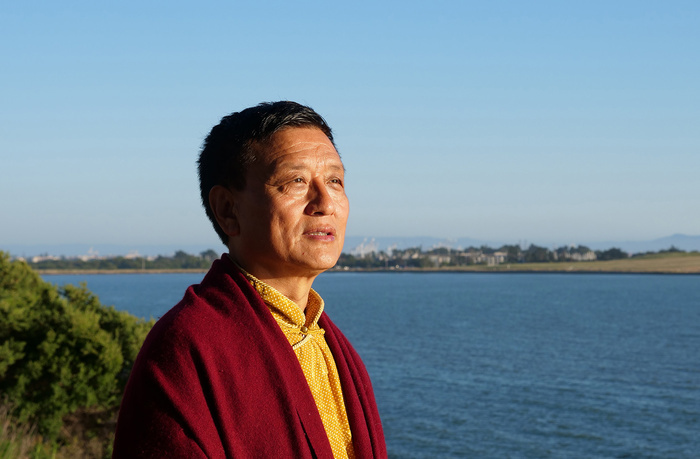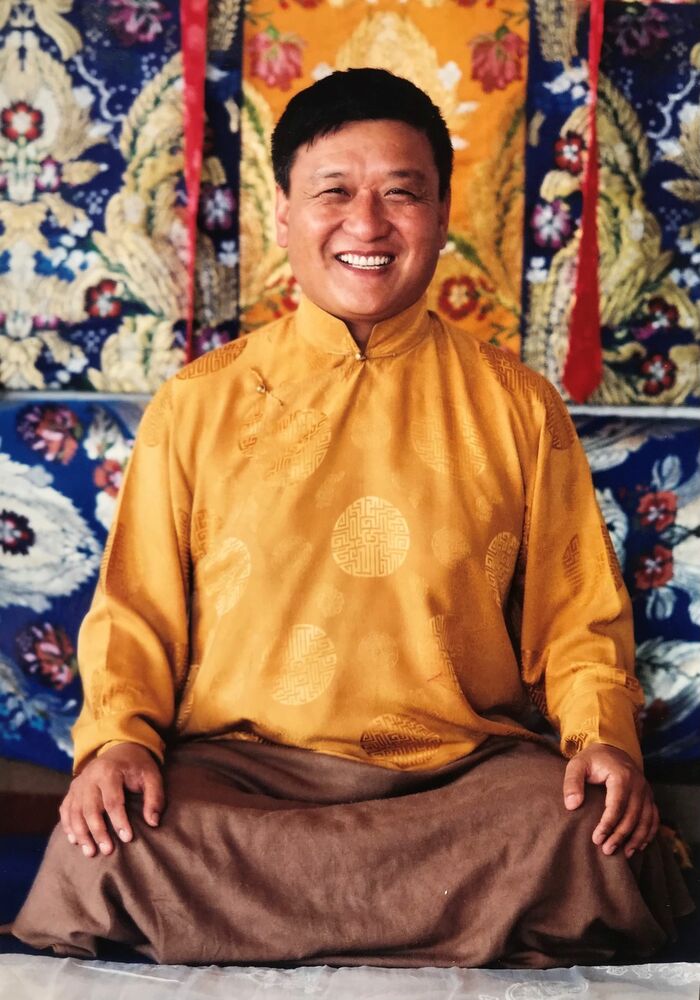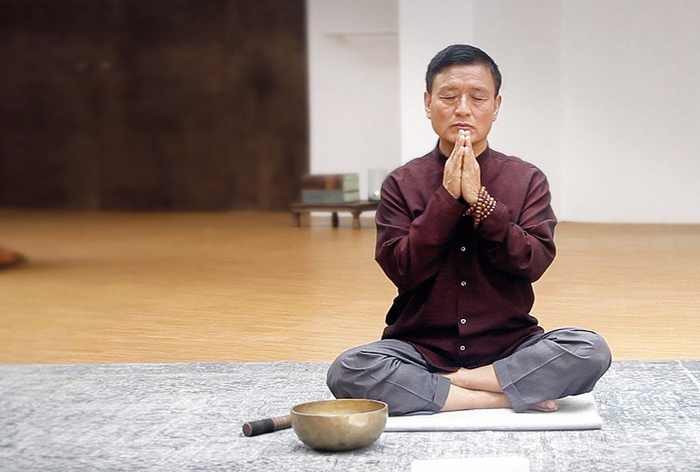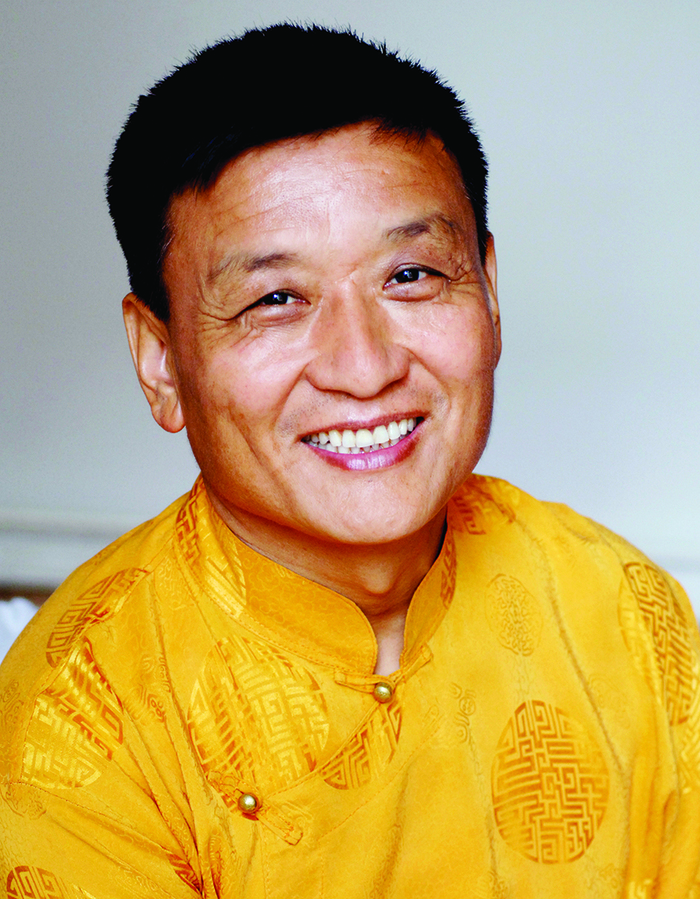
It’s a warm and sunny Sunday in Helsinki, Finland, and I’m on a tram riding through the cobbled streets of Katajanokka, a beautiful harborside area of the city, on my way to meet the highly respected teacher and scholar Geshe Tenzin Wangyal Rinpoche. Renowned for his profound understanding of the ancient Bön tradition, which is the oldest spiritual tradition of Tibet, his work has been instrumental in bringing Bön teachings, meditations, and philosophy to the West. As the spiritual director of Ligmincha International, he offers the world free access to his teachings via his CyberSangha website.
During our conversation, Tenzin Wangyal Rinpoche shared his insights on a range of compelling topics, each shedding light on the path of spiritual awakening. One significant theme we explored was the danger of falling into the trap of extreme thinking, where we believe our own beliefs to be superior or the only valid way. Rinpoche emphasized the importance of cultivating an open mind, embracing diversity, and respecting different paths, as these attitudes can foster true understanding and harmony among individuals and communities.
Rinpoche also delved into the profound significance of the five elements in Bön practice. Drawing upon ancient wisdom, he elucidated how each element – earth, water, fire, air, and space – represents not only external aspects of the world but also inner qualities within ourselves. Understanding and harmonizing these elemental energies can lead to a deep transformation and integration of body and mind.
One of the most fascinating discussions centered around the practice of dream yoga – an ancient discipline that Rinpoche has extensively taught and written about. Rinpoche illuminated the remarkable efficiency of engaging in dream yoga to transform our waking lives. He described how by becoming aware and lucid within our dreams, we can gain insight into the nature of reality, overcome limitations, and develop a more expansive perspective that extends beyond the boundaries of our ordinary existence.
Throughout the interview, Tenzin Wangyal Rinpoche’s gentle demeanor and profound wisdom shines forth for all to see. His teachings not only illuminated the beauty and depth of the Bön tradition but also provided practical guidance for spiritual seekers of diverse backgrounds. Our conversation left a lasting impression and inspires us to embrace open-mindedness, honor the elemental forces within, and explore the rich potential of our dreams to awaken our daily lives. Enjoy!
Study Buddhism: You use the term Bön Buddhism to describe your teachings. What is Bön and how does it differ from Buddhism?
Tenzin Wangyal Rinpoche: The Bön tradition is one of the oldest religious or spiritual traditions of the world and, for sure, the oldest tradition of Tibet. According to the oral history of the Bön tradition, Bön goes back more than 17,000 years, to the Lord Tonpa Sherab Miwoche, who was the founder of Bön Buddhism.
Even though historically Bön and Buddhism seem separate and even had some conflict, now there are not many differences when you look at the nature of the teachings, the nature of the messages, the people practicing. Historically, people can separate Buddhism and Bön. For me, since the teachings are very connected, calling it Bön Buddhism is a way of bringing people, practices and connections closer.
You just mentioned how historically, there has been some conflict between Bön and Buddhism. There are so many branches, traditions and schools of Buddhism and throughout history, and even now, we often see that practitioners get very attached to and protective about whatever lineage they are following. What is your view on this issue?
If you think of Tibetan Buddhism with all the different schools, one of the areas of disagreement is shunyata, which is emptiness. What is the “true” meditation on emptiness? Everybody says, “My version of emptiness is the truth.” This has gone on forever and probably will go on forever in the future. The core teachings, like the realization of emptiness, are about changing your ego, your self-grasping, to transform them fully, to liberate from them. That’s the purpose of meditating on emptiness, shunyata. It’s not to develop a personality, it’s to dissolve the personality.

What I would recommend to people is to not get trapped by these fundamentalist views of “one correct version,” that my version is the correct version. Because when you begin to think in that way, you are trapped into that personality, into that identity, which the teachings are supposed to help you loosen up! So, my advice is to not get trapped in those stories. Apply the true teachings in order to dissolve your self-pain identity, your ego, your personality, your individuality. Because every moment that you feel pain or discomfort is directly connected with your identity. Address that identity through the teachings, don’t just build up a different one!
The Bön tradition has many methods that work with not only our minds but also our bodies, such as yoga exercises, mantra recitation, and breathing practices. How does the body affect the mind?
I think physical exercise, yoga, or what we call “tsa-lung trul-khor” (rtsa-rlung ‘khrul-‘khor) play a very important role in our mental and psychological development and in our meditation. Our experiences of meditation are states of consciousness, states of mind, which are very much affected by the conditions of the body. The body affects the mind, and the mind affects our body. There is an effect both ways.
Some people are more capable of working with the mind and affecting their body, and some people are more capable of working with their body to affect their mind. Working with the mind is very complicated, but they can work on their body. They can learn one exercise or movement, or a specific kind of breath, and by breathing or doing that movement it will affect their mind. For example, if somebody is angry, saying, “Don’t get angry!” or “You’re stupid, don’t get angry!” will not work for sure! So, what do you say? “Calm down, breathe deep, breathe it out.” If you follow the instructions to breathe out, and you do it a few times, you’ll see the mind calming down. This is the power of breath on the mind. In a way, it’s a very smart approach. You’re using something easy, like a movement of the body or the breath in order to transform something that is harder to transform by itself, like a state of consciousness. In effect, you are doing the easier thing to do the harder thing.
Bön considers the five natural elements – earth, water, fire, air and space – as fundamental aspects of a living universe, including all of our experiences. Could you explain their significance for our practice?
The whole universe is created out of the five elements. The external elements are earth, water, fire, air, and space. They correspond to the internal elements out of which the body is created: our flesh, our blood, the heat in our body, our breath, and our consciousness.
In the Bön tradition, we emphasize the five elements a lot. This emphasis is very much on how to recognize one’s own elemental characteristic. Some people are very earth-oriented, some people are very air, some people are very fire. Personalities are different, body types are very different, the psychological states are very different, what they learn and how they develop with their practices are different.

The goal is to balance the five elements. You can do it in two ways. One approach is through meditation, where through balancing the five elements you are affecting your body, environment, and relationship with nature. Those practitioners who find it difficult to understand the subtler and higher aspects of the five elements in the body or in the field of energy can use nature as the basis. There are many shamanic traditions that work with the earth and fire, such as doing sweat lodges, going into mountains and so on. They go outside, work with the outer elements, and when they find balance and a connection to the outer elements, they bring that balance to the internal elements. It’s what we call “internalizing the outer elements to benefit one’s self or one’s being.”
Your best-selling book The Tibetan Yogas of Dream and Sleep is based on your vast experience in dream yoga and provides step-by-step instructions on this powerful method for transformation. How can we use sleep to our advantage?
We sleep through one-third of our lifetime which, on average, is 25 to 33 years. In the West there’s a notion that sleep is wasted time, time is money, and so there’s a negative connection with sleeping. But science and neuroscience demonstrate that the waste cleaning processes in our brain that occur during sleep are very important for our health and well-being.
Yogis also found out that we need to make good use of that time. So, they used dreams as part of their healing process, recognizing their weaknesses, their wounds, their pain, their conflicts, their fears, their anxieties, their depression. They recognized them through their lucid dreaming and tried to transform them through the practices of dream yoga. It wasn’t only to try and clear obstacles and problems, but to awaken their true nature, their enlightened qualities. Dream yoga is used very much for that. The changes in the dream state will then actualize changes in the woken state.
Dream yoga practice is a very important part of the tantric or Vajrayana tradition of Tibetan Buddhism and in the Bön tradition, particularly in the mother tantras.

Most of us think we have control during the day and have no control at night when we go to sleep, but that really depends. We don’t say, “Oh, at 11 o’clock tonight I’ll have a dream with my family!” We don’t have that kind of plan. Dreams happen to us. Why do you dream what you dream? It’s all condition based. Your actions of the day, your emotions of the day, your weaknesses of the day reoccur in dreams. We are basically tested: are we conscious? Are we aware? Are we trapped in our fears? If a demon is chasing you in your dream, are you aware that it’s not a real demon? Are you aware that your fear is producing it? Are you aware that you are, in fact, dreaming? These are the questions.
If you’re trained in dream yoga, you will be able to be lucid. That means that you’ll be aware that you are dreaming. And if you’re aware that you’re dreaming, you’ll know that it’s a dream and it’s not real. You will be aware that you can transform and transcend these feelings and wounds from bad to good, lower to higher, conditioned to non-conditioned, pain to joy. That’s the purpose of dream yoga.
Mantra recitation practices are widespread across Tibet, and mantras are believed to have healing power. In what ways can mantras heal us?
Mantras have power. When you recite them, they have the power to invoke deities and to open chakras, the energy centers.
Often, in our bodies and energy centers, there are a lot of pain stories, wound stories. Every time they’re activated unconsciously, these wound stories give negative vibrations in our body, and it negatively affects us. But when we bring the sound of the mantra to the body, it changes the vibration into a positive one. It heals.
In some of the tantric teachings, it says that if you say the syllables A or HA, just the vibration itself can open up your whole chest, or your heart. If you do 20 minutes or half an hour of mantra recitation on a daily basis, in a couple of weeks it will show results, sometimes even right away.
Finally, for our readers living in a non-stop hectic world, could you recommend an easy meditation to ground the body as well as the mind?
The “Three Precious Pills” is a good, simple meditation for everybody. I call them pills because pills are used so much in the West. There are three pills in the meditation: we have a white pill, a red pill, and a blue pill. When I’m getting agitated with my pain body, when I’m not feeling grounded in my body, I recognize that feeling, and I take the white pill: it gives me stillness and awareness of the stillness in the body. My awareness of the stillness is like the mother, and my body is like the child. These two, child and mother, are connected. Our body is helping our mind to stabilize. Just do that every now and then, maybe ten or fifteen times a day, whenever there’s an opportunity, or whenever you need to do it, such as when you feel restless in your body.

The second pill is the red pill of silence. Very often you listen to the noise, to the problems, you have your own inner voices. These noises never make you feel peaceful, calm or connected to yourself. When you recognize outer or inner noises, at that moment you take a red pill, the awareness of silence. Be silent and be aware of the silence. There is a difference between being quiet and being aware of silence. A big difference. Many people can be quiet, but very few can be aware of their silence. When you are aware of your silence, it has a great impact.
The third pill is the blue pill of the spaciousness of the mind. You take this pill when your mind is agitated, unsettled, fearful, and you will feel the spaciousness of the mind and have the awareness of the spaciousness of the mind. It will be like a crystal clear-blue sky in the desert. It’s helpful to imagine such an image, but more helpful to feel the experience itself.
So, in this meditation you take a white pill, a red pill, a blue pill. You take three pills every day, as many times as you need with no side effects! If I have some free time, or even now in the middle of this interview, I took the three pills, even though I’m not being challenged, and nobody’s threatening me. But there are moments where I feel challenged, then it’s necessary to take those pills to protect yourself or to protect someone else from you! Immediately, when you take these three pills in meditation, it will protect you, it will ground you, it will guide you, and it will transform things for the better. So that’s my simple meditation that one should do every day.
Fantastic, I’ll make sure to use this on a daily basis! Thank you Tenzin Wangyal Rinpoche, for your time and for sharing the ancient wisdom of the Bön teachings.